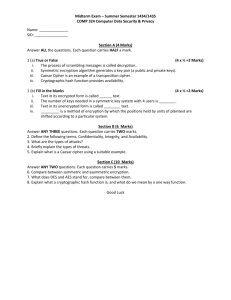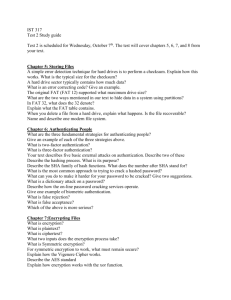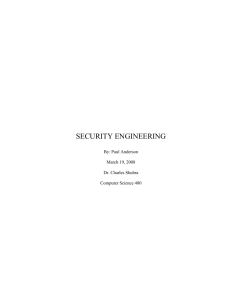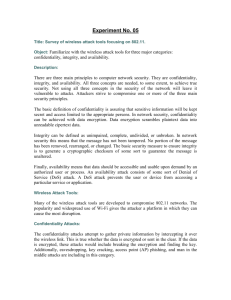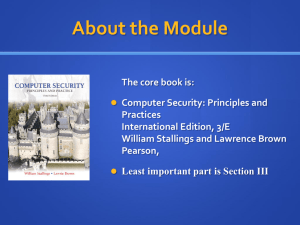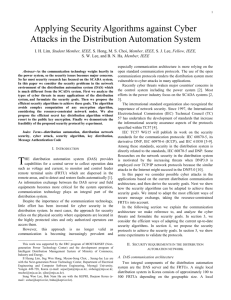- Allama Iqbal Open University
advertisement
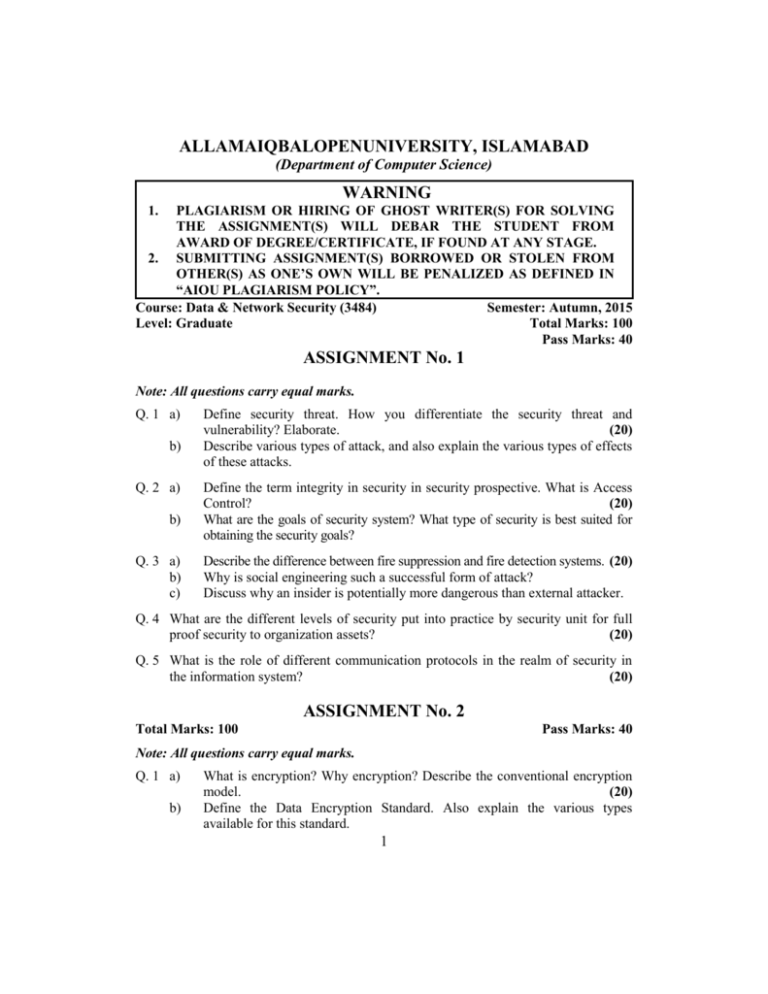
ALLAMAIQBALOPENUNIVERSITY, ISLAMABAD (Department of Computer Science) WARNING 1. PLAGIARISM OR HIRING OF GHOST WRITER(S) FOR SOLVING THE ASSIGNMENT(S) WILL DEBAR THE STUDENT FROM AWARD OF DEGREE/CERTIFICATE, IF FOUND AT ANY STAGE. 2. SUBMITTING ASSIGNMENT(S) BORROWED OR STOLEN FROM OTHER(S) AS ONE’S OWN WILL BE PENALIZED AS DEFINED IN “AIOU PLAGIARISM POLICY”. Course: Data & Network Security (3484) Semester: Autumn, 2015 Level: Graduate Total Marks: 100 Pass Marks: 40 ASSIGNMENT No. 1 Note: All questions carry equal marks. Q. 1 a) b) Q. 2 a) b) Q. 3 a) b) c) Define security threat. How you differentiate the security threat and vulnerability? Elaborate. (20) Describe various types of attack, and also explain the various types of effects of these attacks. Define the term integrity in security in security prospective. What is Access Control? (20) What are the goals of security system? What type of security is best suited for obtaining the security goals? Describe the difference between fire suppression and fire detection systems. (20) Why is social engineering such a successful form of attack? Discuss why an insider is potentially more dangerous than external attacker. Q. 4 What are the different levels of security put into practice by security unit for full proof security to organization assets? (20) Q. 5 What is the role of different communication protocols in the realm of security in the information system? (20) ASSIGNMENT No. 2 Total Marks: 100 Pass Marks: 40 Note: All questions carry equal marks. Q. 1 a) b) What is encryption? Why encryption? Describe the conventional encryption model. (20) Define the Data Encryption Standard. Also explain the various types available for this standard. 1 Q. 2 Explain the concept of key space. How does it improve an algorithm’s ability to protect data? (20) Q. 3 a) b) Explain the working mechanism of Message Digest 5 (MDS5) algorithm with the help suitable scenario. (20) Differentiate between MS5 and Secure Hash Algorithm (SHA). Q. 4 Describe the purpose of transposition, shift, stream and block cipher. Give examples of each. (20) Q. 5 a) b) Describe how gain unauthorized access to a computer system or network is possible through social engineering? (20) Describe the type of information that attackers might try to obtain if they were able to install a sniffer on a network. 3484 Data & Network Security Credit Hours: 3 (3+0) Recommended Book: Principles of Computer Security by Wm. Arthur Conklin, Gregory B. White, Chuck Cothren Course Outlines: Unit No. 1 Introduction and Security Trends The Security problem, Security Incidents Threats to Security, Security Trends Avenues of Attack, Types of Attacks Unit No. 2 General Security Concepts Basic Security Terminology, Security Basics Access Control, Security Models Confidentiality Models, Integrity Models Unit No. 3 Operational/Organizational Security Security Operations in an Organization Standards, and Guidelines The security Perimeter, Physical Security Unit No. 4 Standards and Protocols PIKX/PKCS, PKIK Standards PKCS, X.509, SSL/TLS, ISAKMP, CMP, XKMS 2 Unit No. 5 The Impact of Physical Security on Network Security The problem, Physical Security Safeguards Policies and procedures, Access Controls, Authentication Unit No. 6 Conventional Encryption Conventional Encryption Model, classical Encryption Techniques The Data Encryption Standard (DES), Triple DES Placement of Encryption Function, Traffic Confidentiality Unit No. 7 Authentication and Digital Signatures Authentication requirements, Authentication Functions Cryptographic check sums, Hash Functions Digital Signature Unit No. 8 Cryptographic Algorithms The MD5 Messages Digest Algorithm The Secure Hash algorithm (SHA) Unit No. 9 Attacks and Malware Attacking computer Systems and Networks Denial-of-Service Attacks, Backdoor and Trapdoors, Sniffing, Spoofing Man-in-the-Middle Attacks, Reply Attacks, TCP/IP Hijacking Attacks on Encryption, Password Guessing, Software Exploitation Social Engineering, Malware ========= 3

